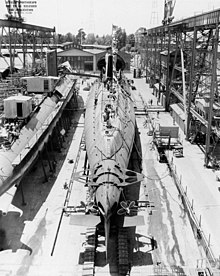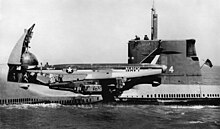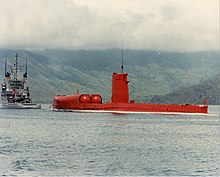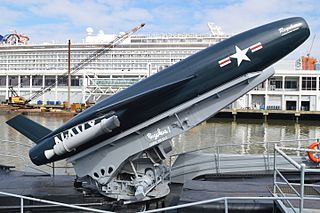
The SSM-N-8A Regulus or the Regulus I was a United States Navy-developed ship-and-submarine-launched, nuclear-capable turbojet-powered second generation cruise missile, deployed from 1955 to 1964. Its development was an outgrowth of U.S. Navy tests conducted with the German V-1 missile at Naval Air Station Point Mugu in California. Its barrel-shaped fuselage resembled that of numerous fighter aircraft designs of the era, but without a cockpit. Test articles of the Regulus were equipped with landing gear and could take off and land like an airplane. When the missiles were deployed they were launched from a rail launcher, and equipped with a pair of Aerojet JATO bottles on the aft end of the fuselage.

USS Barbero (SS/SSA/SSG-317) was a Balao-class submarine of the United States Navy, named for a family of fishes commonly called surgeon fish.

The George Washington class was a class of nuclear-powered ballistic missile submarines deployed by the United States Navy. George Washington, along with the later Ethan Allen, Lafayette, James Madison, and Benjamin Franklin classes, comprised the "41 for Freedom" group of submarines that represented the Navy's main contribution to the nuclear deterrent force through the late 1980s.

USS Theodore Roosevelt (SSBN-600), a George Washington-class submarine, was the second ship of the United States Navy to be named for President Theodore Roosevelt (1858–1919). Initially unnamed and assigned hull classification symbol SSGN-600 as a guided missile submarine, her keel was laid down on 20 May 1958 by the Mare Island Naval Shipyard using components initially assembled for the Skipjack-class submarine nuclear attack submarine USS Scamp (SSN-588). She was named Theodore Roosevelt and redesignated fleet ballistic missile submarine SSBN-600 on 6 November 1958, launched on 3 October 1959, sponsored by Alice Roosevelt Longworth, daughter of Theodore Roosevelt and widow of Nicholas Longworth III, and commissioned on 13 February 1961 with Commander William E. Sims commanding the Blue Crew and Commander Oliver H. Perry, Jr. commanding the Gold Crew.

USS Robert E. Lee (SSBN-601), a George Washington-class fleet ballistic missile submarine, was the only ship of the United States Navy to be named for Robert E. Lee (1807–1870), the commanding general of the Confederate forces during the American Civil War.

USS Halibut (SSGN-587), a unique nuclear-powered guided missile submarine-turned-special operations platform, later redesignated as an attack submarine SSN-587, was the second ship of the United States Navy to be named after the halibut.

USS Growler (SSG-577) was an early attempt by the U.S. Navy to field a cruise missile submarine that would provide a nuclear deterrent using its second series of cruise missiles. Built to deliver the Regulus I cruise missile, Growler was the second and final submarine of the Grayback class, fourth ship of the United States Navy to be named after the growler. Since Regulus I and Regulus II programs had problems, Growler and Grayback were the only two submarines built in this class as instead, the U.S. Navy veered its nuclear deterrence efforts into submarine launched ballistic missiles (SLBMs)—the Polaris missile program.

USS Carbonero (SS/AGSS-337) was a Balao-class submarine, the first ship of the United States Navy to be named for the carbonero, a salt-water fish found in the West Indies.

A cruise missile submarine is a submarine that carries and launches cruise missiles as its primary armament. Missiles greatly enhance a warship's ability to attack surface combatants and strike land targets; although torpedoes are a more discrete option for submerged submarines, missiles give a much longer stand-off range, shorter time to impact the target, as well as the ability to engage multiple targets on different headings at the same time. Many cruise missile submarines retain the capability to deploy nuclear warheads on their missiles, but they are considered distinct from ballistic missile submarines due to the substantial differences between the two weapons systems' flight characteristics; cruise missiles fly aerodynamically using flight surfaces like wings or fins, while a ballistic missile uses its engine power alone as it may exit the atmosphere.

USS Woodrow Wilson (SSBN-624), a Lafayette class ballistic missile submarine, was the only ship of the United States Navy to be named for Woodrow Wilson (1856–1924), the 28th President of the United States (1913–1921). She later was converted into an attack submarine and redesignated SSN-624.

USS Kamehameha (SSBN-642) was a Benjamin Franklin-class ballistic missile submarine and the only ship in the United States Navy to be named after Kamehameha I, the first King of Hawaii. She is one of only two United States ships named after a monarch. She was later reclassified as an attack submarine and re-designated SSN-642.

USS Stonewall Jackson, a James Madison-class fleet ballistic missile submarine, was the third ship of the United States Navy to be named for Confederate States Army General Thomas J. "Stonewall" Jackson (1824–1863).
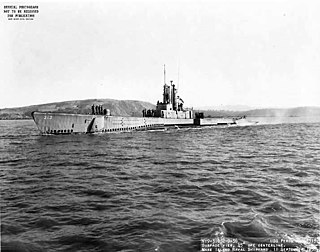
USS Perch (SS/SSP/ASSP/APSS/LPSS/IXSS-313), a Balao-class submarine, was the second submarine of the United States Navy to be named for the perch, a freshwater spiny-finned fish.

USS Cusk (SS/SSG/AGSS-348), a Balao-class submarine of the United States Navy named for the cusk, a large food fish related to the cod.
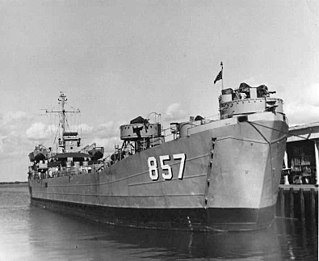
USS King County (LST-857) was an LST-542-class tank landing ship built for the United States Navy during World War II. Named after counties in Texas and Washington, she was the only U.S. Naval vessel to bear the name.
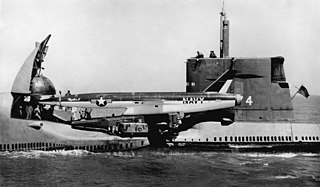
The Grayback-class submarine was a class of two guided missile-carrying submarines of the United States Navy. They carried the Regulus I and Regulus II nuclear cruise missiles, deployed 1957–64, that were rapidly phased out by Polaris Submarine Launched Ballistic Missiles (SLBMs). They and USS Halibut were the sole submarines designed specifically to carry Regulus missiles, and the only submarines capable of carrying Regulus II. However, USS Tunny and USS Barbero were modified earlier to carry two Regulus I missiles per boat.
Submarine Squadron 1 is a squadron of submarines of the United States Navy based at Joint Base Pearl Harbor–Hickam, Pearl Harbor, Hawai'i. The submarines that make up SUBRON 1 include:

The SSM-N-9 Regulus II cruise missile is a supersonic guided missile armed with a nuclear warhead, intended for launching from surface ships and submarines of the U.S. Navy (USN).

Submarine Squadron 15 is a squadron of submarines of the United States Navy based at Naval Base Guam.

The Regulus missile submarines were a group of submarines operated by the United States Navy capable of carrying the Regulus cruise missile. Between 1959 and 1964, a total of five boats were used to undertake the first submarine-based nuclear deterrent patrols by the United States. Regulus submarines were used for this task until 1964, when sufficient ballistic missile submarines carrying the Polaris ballistic missile became available.

